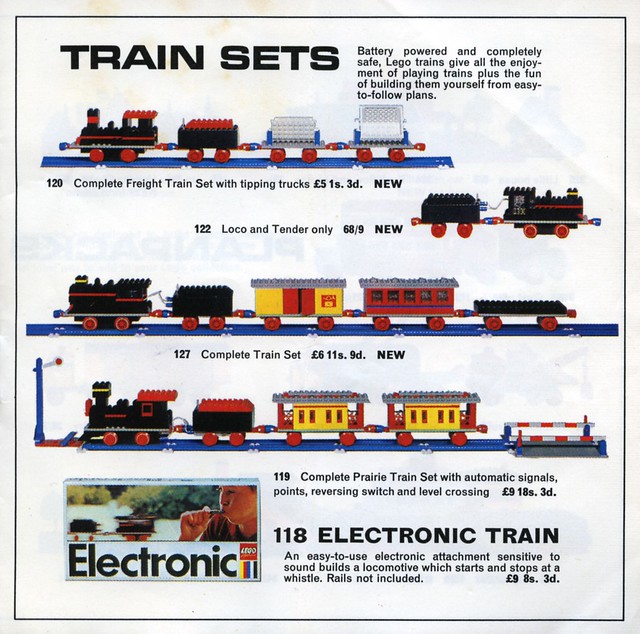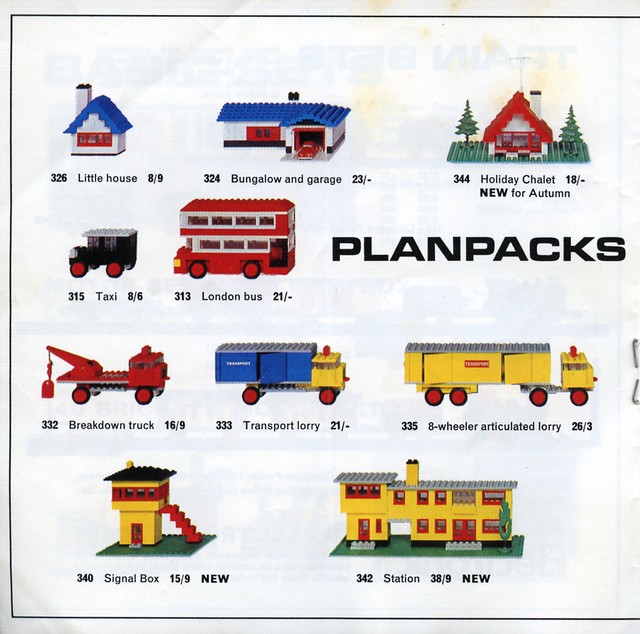ThrowbackThursday: 1969
Posted by Huw,
Since starting this series of Throwback Thursday articles a month ago looking back at old LEGO catalogues I've become a bit obsessed with them.
I've sorted all those I own out and my daughter Alice has been busy scanning them. I've also been filling in the gaps from both BrickLink sellers and bulk lots on eBay and I now own every main UK catalogue from 1966 to 2012, after which they stopped being distributed.
There are now some 51 high quality scans in our catalogue repository, covering the period 1967-1990, and we still have many more to add for that period, along with later ones. I do hope you're finding them useful and interesting and that we are not wasting our time!
Anyway, on to this week's year: 1969. I was knee high to a grasshopper so don't have any recollections of the year but I do remember having quite a few of the sets. I think my father must have been a closet AFOL :)
It may be well before your time, but hopefully you'll still find this article a fascinating glimpse into the past. The catalogue has prices in pounds, shillings and pence which, thankfully, the inflation calculator can handle.
The assortment consisted of just five product ranges: basic sets, train sets, 'Planpacks', supplementary packs and, new for 1969, Duplo.
Trains were a big part of the product range in the late 1960s: three pages out of eight are set aside for them in this catalogue, and some are surprisingly sophisticated: 118 Electronic Train adds the ability to control trains using a whistle! It's interesting to see that they all have magnetic couplings.
Set 119, the largest, weighs in at £9 18s 3d (there were 20s to the £ and 12d (pence) to the s (shilling) ), which according to the calculator is a whopping £153 in today's money which seems incredible!
Planpacks is the name given to sets with instructions to build a speciflc model, as opposed to basic sets which don't come with any. Three of them provide trackside buildings for train layouts, illustrating again how dominant trains were in the range.
More train-related sets...
There's a good selection of supplementary packs available at pocket money prices, although 5/6 equates to £4.20 which is probably more than most kids received each week.
The terminology is particularly interesting on this page.
'Slimbricks' are plates, and bricks are named after the number of studs on them rather than their dimensions: 'eights', 'fours', 'sixteens' etc. 419 contains 15 'sixes'. 421 contains 2 'sixes' but the former contains 3x2 s and the latter 1x6s: very confusing... 427, 428 and 429, however, contain plates whose dimensions are specified.
'Bevelled bricks', whatever next...
The first two Duplo sets were introduced in 1969, although earlier catalogues such as the 1967 one contain 'jumbo bricks' which were, apparently, 'three times the size' of regular bricks rather than two times in each dimension.
So, that's what LEGO looked like 47 years ago. Next week, let's try something different: if you'd like to pick a year that's special to you and write about what's in that year's catalogue, get in touch. I can scan the catalogue, if it's not already been done, and use the images to illustrate your article.
33 likes







38 comments on this article
1978, please :-)
I'm not offering to write about it though ;-)
I remember getting 342 Station. I was quite young though and just thought it was a nice modern house!
Hmmm ... an interesting follow-on to the recent article about the demise of the humble 2x4 brick, because I see a "Cornerbrick" listed above, which I don't remember from my childhood. Certainly a piece that must have disappeared a long time ago, at a guess, because I don't think I've ever seen any mention of it before, at all! A quick search of the database comes up with 1966 as the last appearance - http://brickset.com/sets/417-2/Corner-Bricks-Assorted-Colours - but is it really *that* long since this rather useful piece last appeared?
Having obtained a box of second hand lego in the 80s I have quite a number of these parts. Very interesting to see where they originated.
A couple of cornerbricks are currently helping form a shipwreck. While a couple of red 3-wide doors came in very useful for a fire engine! I can also build a very short railway track...
Last use of the 4x4 corner was in 1969 according to Bricklink (http://www.bricklink.com/catalogItemIn.asp?P=702&in=S) - and, except for a 'gift set', it only ever appeared in service/supplement packs.
An interesting read. I didn't know Duplo bricks had been around so long.
1978 - [Seconded] - Just before Classic Space and Yellow Castle appeared, and the very first Town minifigures still rubbed shoulders with the last (and best) of the hands-in-pockets guys (as they still couldn't get in their cars!)
I'm just amazed on the focus on trains, back in the day. Damn. I wonder why they've fallen so far out of favour with the current generation of buyers?
Really enjoying both the TBT posts and the article catalog. Thanks for all your hard work on it. It's much appreciated!
Thanks a lot. Now I am always looking forward to Thursdays.
This is good and all, but i have one question: What is a train ferry ,and how can i buy 10 of them?
I wonder how many times the stairs to the signal box collapsed whilst being built! Also I thought the end pieces for the tipping truck were relatively new - obviously not.
I would be happy to write up the 22-page 1979 UK catalogue. Can't guarantee that I would be impartial though. I had most of the space sets from that time and remember them with fondness. Ah, nostalgia!
@Panda Hero, A train ferry is a ship for carrying trains usually back and forth between stations on either side of a body of water, e.g. a lake or river, on a fixed or tidal schedule.
Well, don't be afraid those articles are really interesting, and I just fell in love with set 341 the warehouse ;)
@Huw: a little unrelated, but catalogs c88eu3, c89us2, c90eu3 and c90usm2 have a huge first page compared to the other pages. You might want to fix that.
1991 please. It's when I was born!
Interesting that the lorries makes use of the hand of god. I thought that began with Technic in the 90s! I'd also like more information about the automatic garage door. My real life house didn't get an automatic garage door until the mid 80s...
@minimads1980 The clutch power back then was much greater than it is today. I'm sure it was plenty sturdy. I remember sometimes two 2x4 bricks put together lined up on top of one another were hard to take apart so I avoided doing that in my MOCs.
My best find ever was in this! The London Bus!
Great article Huw!!! I am loving throwback Thursday!
@Panda Hero: a train ferry (https://en.wikipedia.org/wiki/Train_ferry) is a real thing, especially around Denmark, though they've mostly been replaced by bridges now. The instructions are available via Brickset (http://brickset.com/sets/343-1/Train-Ferry), and the parts look mostly standard (except for the 1x8 hinge that only ever appeared in this set). I want to build one too now.
@Huw, these articles are great, and make me want to build all the old sets again. Thanks.
I'm loving going back through these scans so thank you Huw, or rather Alice who seems to have done all the hard work!
Its interesting comparing the US and European catalogues and seeing the different naming. I've been looking at Futuron, Space Police I and Blacktron and. perhaps I'm a little biased, but in general I think the now mostly lost UK names are better.
For example in Space Police we had Patrol, Hunter, Powler, Prisoner Transport and Galactic Enforcer rather than the US Message Decoder, Galactic Peace Keeper, Spy-trak, Striker and Mission Commander. For Blacktron it was Strider, Prowler, Cruiser and Star Base rather than the US Alienator, Battrax, Invader and Message-Intercept Base.
It feels like the US names are slightly more descriptive, the UK names more thematic with a little more left to the imagination.
I had some of those trains :)
"We haven't had that spirit here since nineteen sixty nine" - sorry, I just had to :)
These trucks were nice!They had opening doors,hand of god steering and so many functions!
Let's see 1990's catalogue.
I'm a big fan of seeing these scans! The efforts are worth it - THANK YOU! :)
1991 would be interesting. :)
As I was born in December 1968 this was the first catalogue to appear in my life. When I was about ten we got a big lot of second hand Lego and some of these sets were in it.
These are fantastic and bring back so many memories!
I very clearly remember the Large UK ones from 1979 - 82 and wish that I still had them. :-(
It's great to be able to have the next best thing and look at the scans. Thanks Huw! :-)
I'd imagine a one-year-old me literally drooling over this catalogue back then :)
1989 - The start of Pirates and the year that LEGO broke away from the past and started looking forward to the future!
Proper Lego:-)
I'd love to write about 1990, Huw. It's a year close to when I first hit a dark age, but contains a huge number of sets that are incredibly dear to my heart.
I'm really enjoying these Throwback Thursday articles btw, they warm my heart to a ridiculous degree.
Neat to see how far LEGO has come, though I will also add that I miss the pack parts LEGO used to offer up until I think near 2000 that had theme parts and what not (like a trees pack, space pack, castle pack, etc.)
Really enjoying seeing these old catalogues. I'm always surprised to see just how far back my Lego collection goes as I've got a fair few of the corner bricks and a big grey 50 x 50 baseplate.
The automatic garage door always gets me misty-eyed with memory; of all the Lego I had as a child that piece was the closest to magic in my eyes. It took me a long time to adjust to minifig scale when I came out of my Dark Ages, because I spent my childhood making buildings to go with HO trains and Matchbox toy cars. Deep down, that's still what I'd like to do--although Modulars in particular benefit from the larger scale!
Note that "Lego" is NOT all uppercase. It wasn't until the 1980s that they started insisting it was an acronym and should always be written in uppercase.